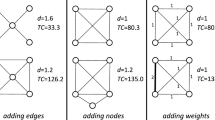Introduction
The past decade witnessed an advancement of researches on complex systems by the rise and development of new network science. With respect to product space evolution and economy development issues, Hidalgo, Barabasi and Hausmann introduced an outcome-based measurement to quantify proximities among products that countries export, and used network representations to visualize proximities among products [1]. Through which, they applied theory and methods from physics and economics to model and map the impact of “The Product Space” on the development of nations [1]. The map depicts co-export patterns of 775 industrial products exported by 132 countries during 1998-2000. With the help of network expression, they found that “most upscale products are located in a densely connected core while lower income products occupy a less connected periphery” [1].
Access this chapter
Tax calculation will be finalised at checkout
Purchases are for personal use only
Preview
Unable to display preview. Download preview PDF.
Similar content being viewed by others
References
Hidalgo, C.A., Klinger, B., Barabási, A.-L., Hausmann, R.: The Product Space Conditions the Development of Nations. Science 317(5837), 482–487 (2007)
Schweitzer, F.: Modelling Migration and Economic Agglomeration with Active Brownian Particles. Advances in Complex Systems 1(1), 11–37 (1998)
Walshaw, C.: A Multilevel Algorithm for Force-Directed Graph Drawing. Journal of Graph Algorithms and Applications 7(3), 253–285 (2003)
Author information
Authors and Affiliations
Editor information
Editors and Affiliations
Rights and permissions
Copyright information
© 2013 Springer-Verlag Berlin Heidelberg
About this paper
Cite this paper
Jiang, B., Yang, C., Peng, S., Li, R., Terano, T. (2013). A Brownian Agent Model for Analyzing Changes in Product Space Structure in China. In: Demazeau, Y., Ishida, T., Corchado, J.M., Bajo, J. (eds) Advances on Practical Applications of Agents and Multi-Agent Systems. PAAMS 2013. Lecture Notes in Computer Science(), vol 7879. Springer, Berlin, Heidelberg. https://doi.org/10.1007/978-3-642-38073-0_29
Download citation
DOI: https://doi.org/10.1007/978-3-642-38073-0_29
Publisher Name: Springer, Berlin, Heidelberg
Print ISBN: 978-3-642-38072-3
Online ISBN: 978-3-642-38073-0
eBook Packages: Computer ScienceComputer Science (R0)




